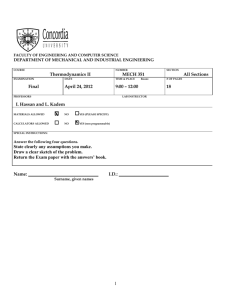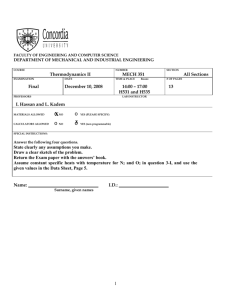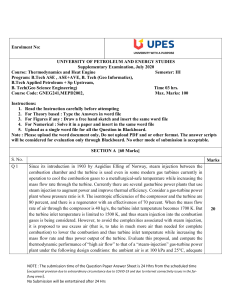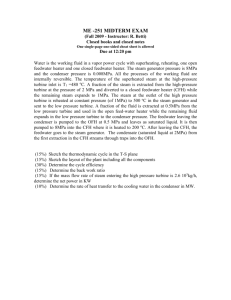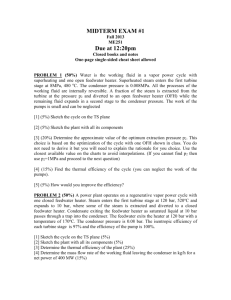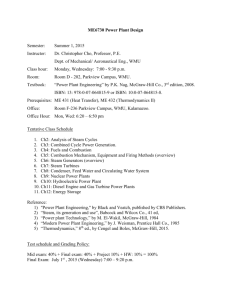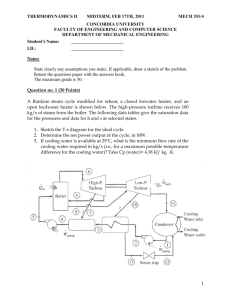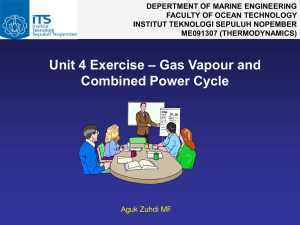flow combustion
advertisement
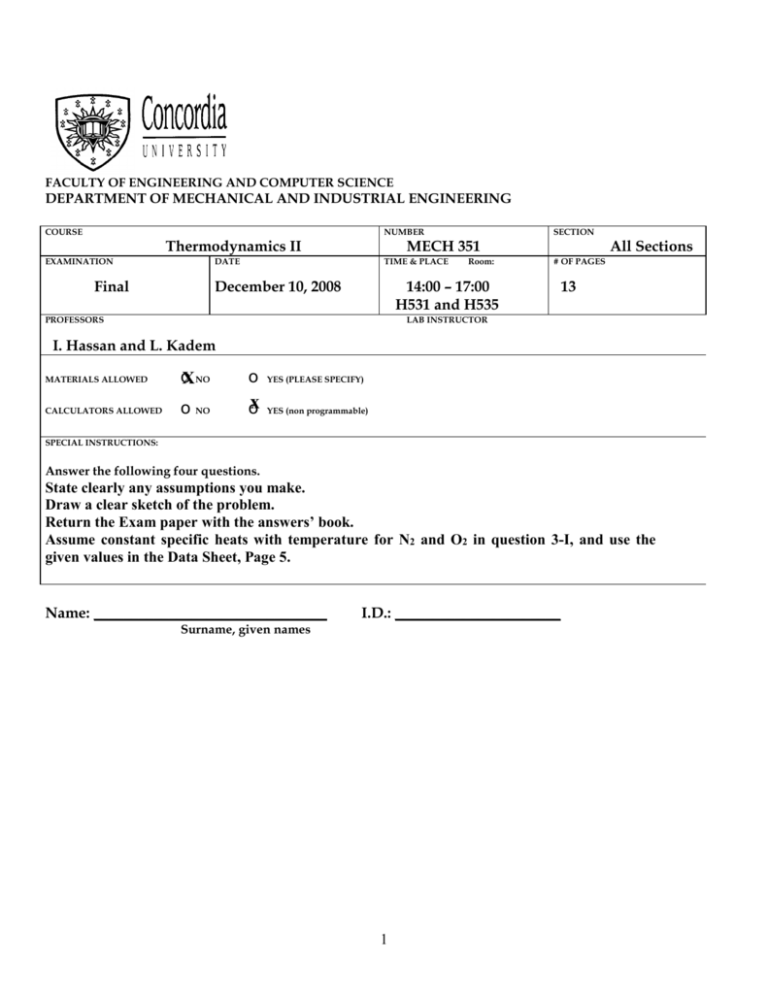
FACULTY OF ENGINEERING AND COMPUTER SCIENCE DEPARTMENT OF MECHANICAL AND INDUSTRIAL ENGINEERING COURSE NUMBER Thermodynamics II EXAMINATION MECH 351 DATE Final SECTION TIME & PLACE December 10, 2008 Room: All Sections # OF PAGES 14:00 – 17:00 H531 and H535 PROFESSORS 13 LAB INSTRUCTOR I. Hassan and L. Kadem MATERIALS ALLOWED oX NO o YES (PLEASE SPECIFY) CALCULATORS ALLOWED o NO ox YES (non programmable) SPECIAL INSTRUCTIONS: Answer the following four questions. State clearly any assumptions you make. Draw a clear sketch of the problem. Return the Exam paper with the answers’ book. Assume constant specific heats with temperature for N2 and O2 in question 3-I, and use the given values in the Data Sheet, Page 5. Name: _______________________________ I.D.: ______________________ Surname, given names 1 Question no. 1 (30 Points) Consider a cogeneration power plant modified with regeneration. Steam enters the turbine at 6MPa and 450°C at a rate of 20 kg/s and expands to a pressure of 0.4 MPa (state # 7). At this pressure, 60 percent of the steam is extracted from the turbine ( m 7 0.60 m 6 ), and the remainder expands to a pressure of 10 kPa (state # 11). Part of the extracted steam at 7 is used to heat feedwater in an open feedwater heater. The rest of the extracted steam is used for process heating and leaves the process heater as a saturated liquid at 0.4 MPa. It is subsequently mixed with the feedwater leaving the feedwater heater, and the mixture is pumped to the boiler pressure. The steam in the condenser is cooled and condensed by the cooling water from a nearby river, which enters the adiabatic condenser at a rate of 463 kg/s. Show the cycle on a T-s diagram, relative to the saturation line, and determine: (a) The total power output of the turbine. (b) The temperature rise of the cooling water from the river in the condenser (Cp = 4.18 kJ/kg.oC, for water). (c) The mass flow rate of steam through the process heater. (d) The rate of heat supply from the process heater per unit mass of steam passing through it. (e) The rate of heat transfer to the steam in the boiler, and the utilization factor (u) of the cycle. 9 2 Question no. 2 (20Marks): A gas-turbine power plant operates on the simple Brayton cycle with air as the working fluid and delivers 15 MW of power (Hint: turbine power minus compressor power). The minimum and maximum temperatures in the cycle are 310 and 900K, and the pressure of air at the compressor exits 8 times the value at the compressor inlet. Consider an adiabatic efficiency of 80 percent for the compressor and 86 percent for the turbine, and assume k =1.4 for air. Sketch the cycle on T-s and P-v diagrams and determine: (a) The mass flow rate of air through the cycle. (b) The thermal efficiency of the cycle. Question no. 3 (25 Marks) I- An insulated tank that contains 1 kg of O2 at 15°C and 300 kPa is connected to a 2 m3 uninsulated tank that contains N2 at 50°C and 500 kPa (see figure below). The valve connecting the two tanks is opened and the two gases form a homogeneous mixture at 25°C. Considering ideal gas mixture, determine: a- The final pressure in the tank. b- The heat transfer. II- Atmospheric air enters an air-conditioning system at 30oC and 70 percent relative humidity with a volume flow rate of 4 m3/min and is cooled to 20oC at a pressure of 1 atm, as shown in the figure. The system uses refrigerant-134a as the cooling fluid that enters the cooling section at 350kPa with a quality of 20 percent and leaves as a saturated vapor. a- Sketch the process on the psychrometric chart. b- What is the heat transfer from the air to the cooling coils, in kW? c- If any water is condensed from the air, how much water will be condensed from the atmospheric air per min? d- Determine the mass flow rate of the refrigerant, in kg/min. 3 Question no. 4 (25 Marks) Liquid octane (C8H18) enters a steady-flow combustion chamber at 25°C and 101 kPa at a rate of 0.4 kg/min. It is burned with 50% excess air that enters at 25°C and 1 atm. After combustion, the products are allowed to cool to 500K, at a pressure of 101 kPa. Assuming complete combustion and that all the H2O in the products is in gas form, determine: a- The mole fraction and the partial pressure of CO2 in the products. b- The air-fuel ratio in this combustion process. c- The heat transfer rate from the combustion chamber. 4 s THERMODYNAMICS DATA SHEET R = 8.315 kJ/kmole°K 1 bar = 100kPa 1 gm/cm3 = 103 kg/m3 Molar masses and specific heats: Air: M = 29 Cp= 1.005kJ/kg°K O2: M = 32 Cp= 0.918kJ/kg°K N2: M = 28 Cp= 1.039kJ/kg°K Enthalpy of Formation: 5 Note: Cp = Cv + R and k = Cp/Cv 6 7 8 9 10 . 11 Formula Sheet – Thermodynamics II T2 V1 T1 V2 K 1 T P ; 2 2 T1 P1 K 1 K K P V ; 2 1 ; P1 V2 W Vmax Vmin MEP= ; where K= cycle Ws W CP ; P ;T a ; Wa Ws CV Wnet Qin Ni m ; Average molar mass M m = m = yi M i ; gas constant: Nm Nm P V N R Rm u Ru 8.314 KJ /( Kmol.K ) ; PV ZNRuT ; (Zm yi Zi ) ; i i i yi ; Mm Pm Vm Nm Mole number: Ni mi ; Mole fraction: yi Mi Dalton’s law: Pm Pi (Tm .Vm ) ; Amagat’s law: Vm Vi (Tm .Pm ) ; U m = mfiU i , U m = yi U i (same for h and s); Cv,m mfiCv,i ; C v,m yi C v,i , same for Cpm Real gasses: h (h2 h1 ) ideal Ru Tcr ( Z h 2 Z h1 ) ; u (h2 h1 ) Ru (Z 2T2 Z1T1 ) ; s (s2 s1 )ideal R(Zs2 Zs1 ) ; . Air conditioning energy balance: Q in . . . . . m air . ; m=NM ; m fuel Enthalpy of combustion . out . Air fuel ratio: AF . W in mi hi Q W out me h e , m m a Pvi Ptotal mair,act N air,act Ni ; Percentage of theoretical air: or Ntotal mair,th N air,th : hc=H prod H react ; HHV LHV (mhf ) H2O ; g First law analysis of reacting systems: Q W N p (h f h h) p Nr (h f h h)r Entropy generation of reacting systems: S gen N p s p N r s r yP N p s o i T , Po Ru ln i m Po yP N r s o i T , Po Ru ln i m Po Pr od 12 react Summary of Final Answers Question No 1: Required (a) Turbine power output. Numerical Final Answer (b) Cooling water temperature rise. (c) Heater mass flow rate. (d) Heat supply, process heater. (e) Boiler heat transfer and utilization factor. Question No 2: Required (a) The mass flow rate of air. Numerical Final Answer b) The thermal efficiency. Question No 3: IRequired (a) Final Pressure. Numerical Final Answer b) Heat Transfer. IIRequired (a) Heat transfer from the air in kW. (b) How much water will be condensed, if an. (c) Determine the mass flow ate of the refrigerant, in kg/min. Numerical Final Answer Question No 4: Required (a) The mole fraction and the partial pressure of CO2. (c) The air-fuel ratio. (d) The heat transfer rate from the combustion chamber . 13 Numerical Final Answer
